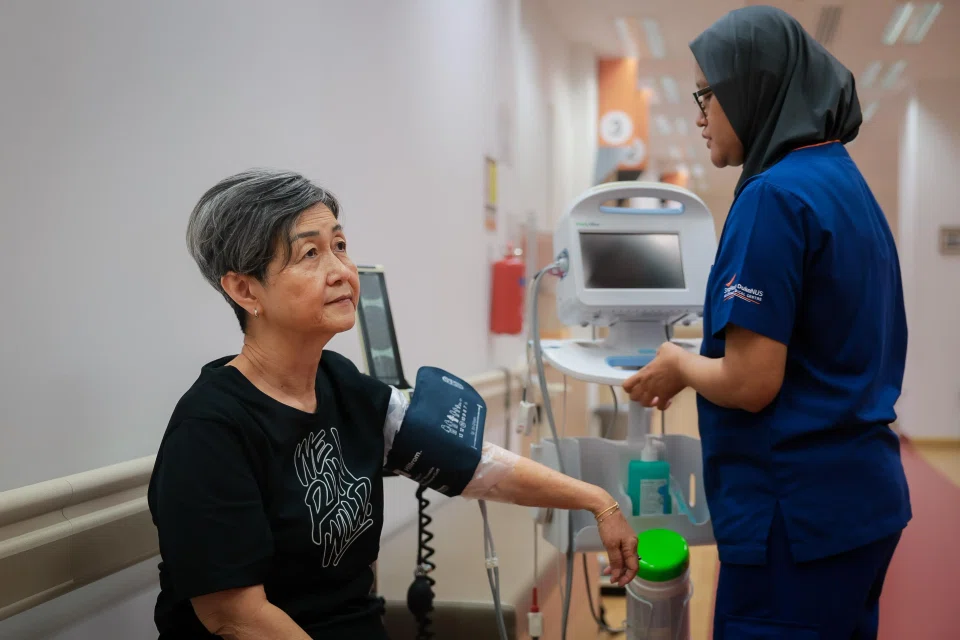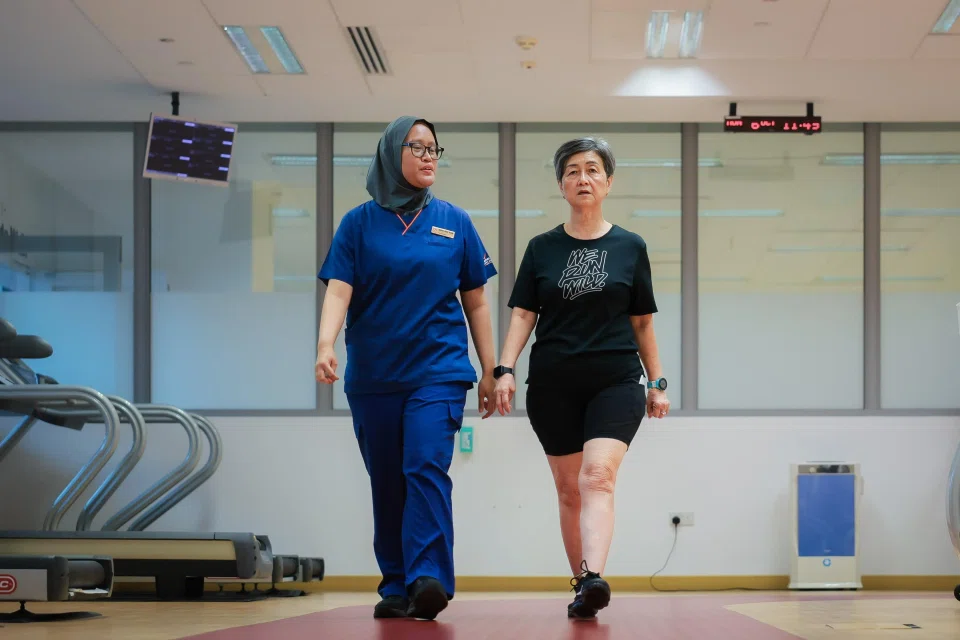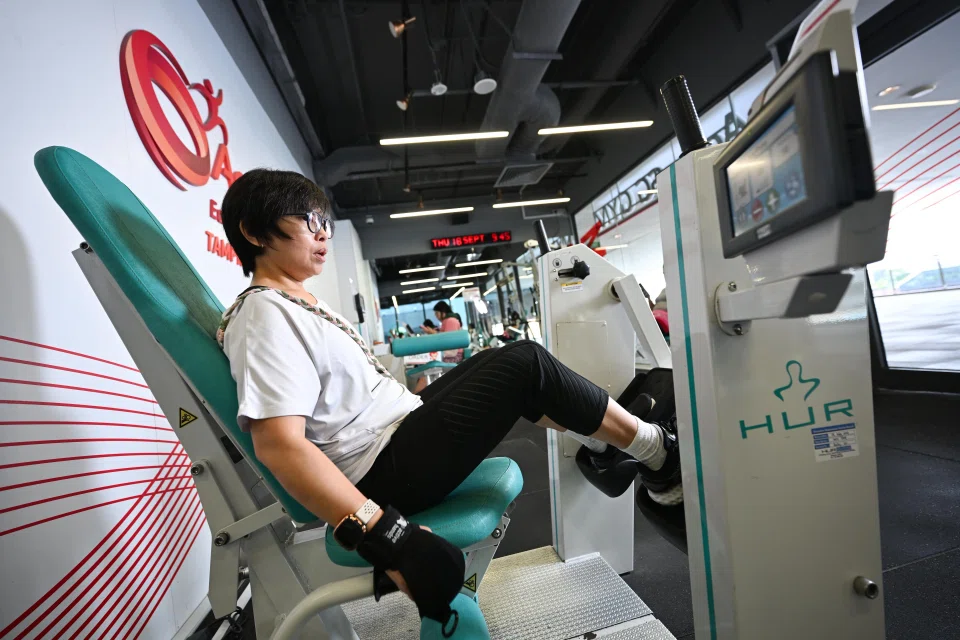Exercising safely to manage a silent killer: high blood pressure
Akshita Nanda for The Straits Times
Madam Low, a 55-year-old freelance IT professional, was concerned that her blood pressure was sometimes higher than normal. So, she signed up in September for a six-session programme which would teach her how to manage blood pressure with exercise.
Manage Hypertension With Exercise is run by nationwide health and wellness initiative Active Health, which is under sports body Sport Singapore. It costs $48 for six sessions and was started in 2022.
In 2025, about 500 people have signed up for it from January to September. Madam Low, who wants to be known only by her surname, tells The Straits Times that her blood pressure is mostly normal - readings of below or around 120mmHg systolic and 80mmHg diastolic. Recently, however, the doctor has sometimes recorded higher readings of about 140/90.
"I don't know if it's because I didn't sleep well the previous night or I was nervous when my blood pressure was checked," she says. "I'm curious what the effect of exercise will be on my blood pressure."
Blood pressure refers to the pressure at which blood is pumped around the body. High blood pressure can, over time, damage blood vessels and organs, as well as increase one's risk for strokes, cardiac events and dementia.
Doctors and healthcare professionals say exercise is a key pillar of blood pressure management, but that many with high blood pressure may not know how to exercise safely or at what intensity.
Blood pressure rises during exercise and can fall afterwards, which means that people with hypertension need to monitor their condition.
Before joining the Active Health programme, participants have to do a survey, listing their health conditions and medications.
They check their blood pressure before the coaching session starts and wear a fitness watch to monitor their heart rate during the session.
Active Health coach Christopher Huang says a reading of around or above 200/110 would disqualify the participant from exercising.
At National Heart Centre Singapore (NHCS), physiotherapists begin exercise sessions only if a patient's blood pressure is in the range of 90/60 to 160/90.
Senior physiotherapist Nadiah Mohamed Rahim, who is with NHCS' cardiac physiotherapy services, says if the patient's blood pressure is higher than 160/90, he or she is asked to rest and do deep breathing. He or she is also interviewed to find out what factors might be contributing to the high reading.
"If you have not been sleeping well or are sick, your blood pressure will be higher than usual," she says. "Your emotional state can also trigger high blood pressure."
High blood pressure a silent killer
According to the National Population Health Survey in 2023, 15 per cent of Singapore residents aged 18 to 74 reported that they had hypertension, or high blood pressure, and were prescribed medication.
There could be even more who are undiagnosed, say doctors, since high blood pressure typically has no symptoms.
Dr Benjamin Tan, a neurologist who supports stroke survivors at Singapore National Stroke Association (SNSA), calls hypertension a silent killer. "You can feel perfectly fine while your blood vessels are under dangerous stress," he says.
It is important to raise awareness of regular monitoring and treatment of high blood pressure, he adds.
Blood pressure should be checked once every two years, or more frequently as the doctor advises, for healthy adults aged 18 and older.
Hypertension can be managed through medication and dietary changes such as reducing salt and increasing fibre intake; managing stress; and doing at least 150 minutes of moderate exercise every week. This is in line with the Singapore Physical Activity Guidelines - though Dr Tan cautions that stroke survivors and those with medical conditions should seek medical advice before exercising.
"Regular aerobic exercise can reduce systolic blood pressure by about 5mmHg to 8mmHg in the long run. While modest, this translates to significant stroke-risk reduction," says Dr Tan, who is also adjunct assistant professor and a consultant at National University Hospital's division of neurology, department of medicine.
Aerobics, resistance training or isometric exercises?
Assistant professor Ho Jien Sze, a senior consultant at NHCS' department of cardiology, says blood pressure rises during exercise as muscles require increased blood supply. Post-exercise, blood pressure drops temporarily, even for several hours.
Traditional aerobic exercise or cardio - including walking, jogging, cycling and swimming - is recommended mostly for the management of high blood pressure, she adds.
Resistance training or strength training, which is using free weights or machines to do moves such as squats and chest presses; a combination of cardio and weights; and isometric exercise, which includes wall squats or leg extensions held for a prolonged period of time, can also lead to blood pressure reduction. Some studies have found that isometric exercises were most effective in reducing systolic and diastolic blood pressure.
However, resistance training can cause higher spikes in blood pressure than aerobic exercise, which can be more dangerous for beginners.
Assistant professor Yeo Tee Joo, a senior consultant at National University Heart Centre, Singapore's department of cardiology, says this is because people tend to hold their breath - the Valsalva manoeuvre - and brace their core while lifting weights. This substantially increases the pressure within the chest and abdominal cavities.
Even isometric exercises, which require sustained muscular contraction and prolonged holding of positions, will increase blood pressure during the period of exercise.
"For those with hypertension, especially if not well controlled, it is safer to avoid instances in which the blood pressure can spike to extremely high levels," he says. "In such situations, starting with low- to moderate-intensity aerobic exercise, low-volume resistance training and short durations of isometric stretching is advisable."
The good news is that regular physical activity makes blood vessels more elastic. "This reduces the force and, consequently, blood pressure within the blood vessels. The heart is also strengthened and can pump more blood at a lower heart rate and with less effort, contributing to lower blood pressure," says Prof Yeo.
Exercising safely with hypertension
Madam Teo Soon Hwa, 66, had a heart bypass in 2023 after several years of taking medication for high blood pressure. After her surgery, she did cardiac rehab and physiotherapy at NHCS, but stopped exercising for a year because of lower back pain. She works part-time in retail operations.
She continued to go on walks and stretch at home, but in 2025, her doctor advised her to restart a structured exercise programme to manage her medical conditions, which include elevated blood pressure.
Her physiotherapist, Ms Nadiah, checks that Madam Teo's blood pressure is within the safe range, and that she is wearing a heart-rate monitor.
Then, she gets Madam Teo to warm up with a brisk walk, before moving on to cardio exercises, such as using a recumbent stepper to reduce the chances of back pain.

Madam Teo also does bicep curls with free weights or uses a machine to do chest presses.
Ms Nadiah checks that Madam Teo is breathing properly. "You must breathe out when you exert force and breathe in when you relax," she says.
She also monitors the pace of the exercise to ensure it is not too vigorous or fast. Over time, she may increase the number of repetitions or add more challenging exercises.
Slow and steady progression is best, says Ms Nadiah. "Sometimes, people think that only vigorous exercise will help, but that's not true."
She adds that it is important to look out for adverse symptoms while exercising, and stop if any manifest. "To ensure safety, we emphasise proper breathing - monitoring symptoms such as dizziness, chest pain or shortness of breath - and encourage moderate rather than extreme exercise intensities," she says.
Madam Teo is learning how to pace herself and use the exercise machines safely. She plans to transition to regularly visiting an Active SG gym near her home instead.
"But I'm more motivated to come here," she says. Her physiotherapist keeps her accountable.

Dr Isaac Lim, deputy director of programme design and development at Active Health, Sport Singapore, says many people with chronic conditions fear that exercising will put them at risk of an adverse health event.
That is why Active Health offers structured programmes to manage hypertension and osteoarthritis, diabetes and obesity. They focus as much on motivating participants to build healthy habits, as on exercise sessions. Madam Low, for example, was surprised that one session focused on her vision for her health, rather than on just doing exercises. Yet, motivation is key to building an exercise habit in the long term.
Ms Wendy Leaw, 49, used to jog almost every day, but avoided going to the gym. Then the homemaker and mother of three kids aged 10 to 14 had a stroke in 2023.
Her rehabilitation journey included occupational therapy, music therapy, speech therapy and physiotherapy.
After being told that she needed to build muscle strength, she engaged a physiotherapist to train her in gym routines. She now goes at least once a week to the ActiveSG gym at Our Tampines Hub.

Her right hand was affected by the stroke, so she uses a modified glove to help her grip equipment. "I feel a lot stronger," she says. "Last time, when I jogged, my arm flapped like a chicken wing. Now, my whole body is stronger."
Ms Leaw works out with other stroke survivors at the gym. They also go for walks and have a dragon boat team. "I look forward to each training session because I'm with my friends," she says.
This is an example of the multiple health benefits of exercise, says Dr Tan. Apart from managing blood pressure, blood sugar and cholesterol, exercise has psychological benefits.
Stroke survivors often feel socially isolated and worry about their health. Group exercise sessions organised by SNSA, such as a fund-raising walk on Oct 25, help stroke survivors interact with others and get confident that they are reducing their risk of a second stroke.
Dr Tan says: "What I always tell people is that you don't need to become a marathon runner. Simple, sustainable changes like taking stairs instead of escalators, parking farther away or joining community exercise groups can make a real difference."
- For more information on SNSA's Stepping Out For Stroke 2025 walk on Oct 25, go to snsa.org.sg/sofs2025
